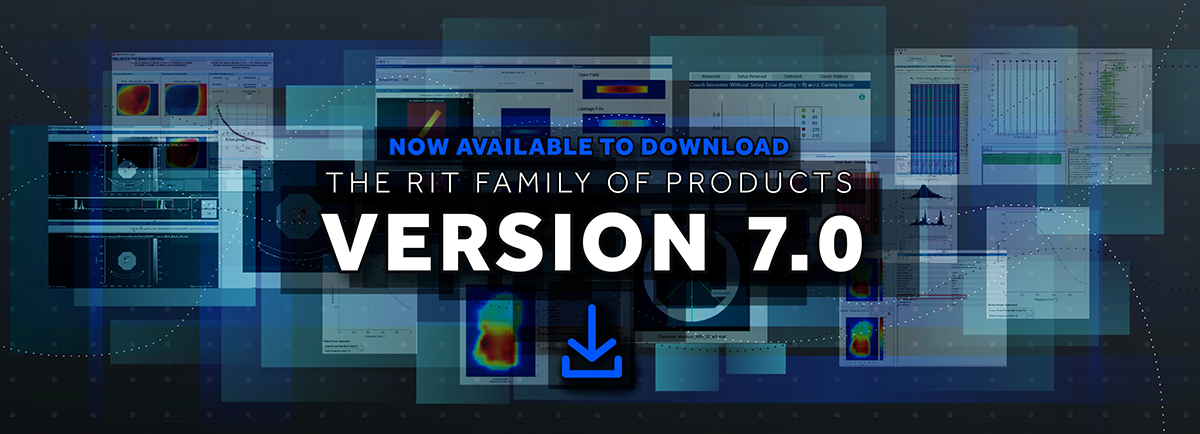What's New in V6.11
THE RIT FAMILY OF PRODUCTS: Version 6.11
RIT's new software update, the RIT Family of Products - Version 6.11 was released on February 15, 2023. Customers in-support with our Product Maintenance Program (PMP) are able to easily download the update for free online. This update is available for all software product packages, including: RIT Complete, RIT Classic, RITG135, RITG142, RITG148+, RIT Film, Radia Therapy, and Radia Diagnostic. If you have not already downloaded Version 6.11, we encourage download this update as soon as possible in order to benefit from our latest innovations, enhanced capabilities, and most up-to-date cybersecurity features.
MLC QA
Varian Halcyon® RapidArc® and Picket Fence Analysis
By popular demand, RIT has extended our traditional RapidArc MLC analyses to support Varian Halcyon LINACs. In addition to the Millennium 120 and HD120 models, Halcyon users now have the option to perform fully automated RapidArc QA, with the flexibility to use distal, proximal, or dual MLC configurations. Halcyon support has been extended to all of RIT’s RapidArc modules (Tests 0.1, 0.2, 1.1, 1.2, 2, and 3) and the standard automated Picket Fence test.
Easily select the test and MLC model you are using from a drop-down menu, and the software will take care of the rest with an automated analysis.
Halcyon® and RapidArc® are registered trademarks of Varian Medical Systems, Inc.



Varian RapidArc® Tests: New Routines, Interface, and Workflow
- The new RapidArc Test 0.1 (dMLC Dosimetry) interface simultaneously loads and analyzes four cardinal gantry angle images and provides full automation for quick results. Simply select the folder containing the four cardinal images and the software will automatically parse them by the gantry angles and complete the analysis.
- RIT software also features the new RapidArc Test 2 (Dose Rate and Gantry Speed) and Test 3 (Leaf Speed) routines for analyzing the various test modes against an open field image. The analysis settings can be fully customized and are automatically saved for future use. Investigate between-image intensities with a click-and-drag horizontal profile line. Customize the dimensions and vertical positioning of the sub-ROIs and investigate between-image intensity with a click-and-drag horizontal profile line.
- RIT has upgraded to the latest Varian requirements for these tests, ensuring you stay current and in compliance.
Enhanced Automation Workflow of RapidArc® & Picket Fence Analyses
RIT software has significant enhancements in RapidArc Tests 0.2, 1.1, and 1.2, and the standard Picket Fence test for MLC QA. These three tests share many common “picket fence” procedures that are improved in Version 6.11. This includes:
- Automated Preprocessing for Rotational and Translational Alignment:
If the EPID or collimator has been rotated or shifted, the software will automatically adjust for it to provide accurate and reliable results. - Expanded Individual Leaf Analysis:
Customize the range of leaves that are analyzed, regardless of MLC model: Millennium 120, HD120, or any of Halcyon’s three configurations. - Support for Common EPID Sizes:
Including 30x30, 30x40, 40x30, 40x40, and 43x43 cm.

Machine QA

Enhanced & Expanded Isocenter Optimization (3D Winston-Lutz) Routine
Isocenter Optimization for Elekta Unity:
RIT’s popular 3D Winston-Lutz (Isocenter Optimization) routine now supports analysis on the Elekta Unity machine, an MR-LINAC machine that combines diagnostic quality MR imaging with a linear accelerator. Elekta users can now utilize RIT’s most popular analysis routine to automatically process a set of EPID Winston-Lutz images for fast, sub-millimeter accuracy of isocenter position.
Automated File Name Generation:
RIT's 3D Winston-Lutz routine now includes the new Automated File Name
Generation feature. The file name for PDF and ASCII analysis results will be automatically exported and generated with a timestamp and pass/fail status of results. This will save users time and improve workflow efficiency.
Updated Interface:
When analyzing a range of 3 to 16 images with RIT’s 3D Winston-Lutz routine, all images are now featured in the same interface window. This eliminates the need for any scrolling and ensures a comprehensive picture of your analysis results, all in one place.
More Flexible Pass/Fail:
Users may now choose to pass or fail on the Maximum Machine Deviation (R) or the Total Maximum
Deviation (W), which includes the ball setup error
Enhanced Fully Automated Star Shot Analysis
In the Fully Automated Star Shot Analysis routine, a second beam center detection algorithm has been added. This allows for greater flexibility when performing star shot analysis.

Patient QA
Plan-Based Calibration for TomoTherapy® Registration
Utilize RIT’s patented* Plan-Based Calibration technology to simplify your TomoTherapy Registration process for patient QA. With Plan-Based Calibration, a calibration file is no longer needed, the scanner warm up is minimized, and variation in development time after exposure is no longer a significant factor. This saves you time and money, and could potentially improve patient throughput. Additionally, there is no longer a need for blue or green channel corrections, eliminating a complicated and cumbersome multi-channel correction process.
Plan-Based Calibration is also a more accurate method (normalization within 1 cGy), as it is precisely tailored to each specific film, with as many data points as the user needs. It accounts for variation between film and scanners and generally increases passing capability. New guidance for tighter tolerances in TG306, TG-148’s replacement task group, raises the bar on gamma passing criteria. Plan-Based Calibration can increase the accuracy of this test, and your gammas are more likely to improve.
*Patents: EP 1683546, CA 2567197, JP 4366362, JP 4838161, US 7024026, US 7233688, US 7639851, and US 7680310.
TomoTherapy® is a registered trademark of Accuray, Inc.

Imaging QA/QC

EPID QA Phantom Couch Analysis
In addition to the phantoms being placed on an imager, RIT software can now analyze the EPID QA phantom (RIT EPID), manufactured and sold by Standard Imaging, when placed directly on the couch. The phantom’s magnified dimensions are automatically calculated from the phantom size. Placing the phantom on the couch provides an analysis that is closer to realistic patient positioning.
This update provides physicists with more setup options when performing phantom analyses, including Varian Halcyon® users, whose imaging panels are inaccessible, and phantoms must be placed directly on the couch.

 Expanded Catphan® Materials Analysis
Expanded Catphan® Materials Analysis
RIT’s enhanced Catphan Materials analysis will now analyze both horizontal slices and both vertical slices with ramps. Additionally, we have added a measure of the yaw and tilt of the phantom, based on these ramps. This is intended to improve your accuracy and efficiency by optimizing proper phantom alignment.
Catphan® is a registered trademark of The Phantom Laboratory.
 QC-3 & QC-kV1 Phantom Uniformity Analysis
QC-3 & QC-kV1 Phantom Uniformity Analysis
RIT's software packages for therapeutic phantom analysis now have an added uniformity analysis for the QC-3 and QC-kV1 phantoms from Standard Imaging. The QC-3 is used for MV (EPID) imaging and the QC-kV1 is used for planar kV imaging.
Enhanced Tolerance Customization
RIT's Tolerance Manager, used in our automated phantom analysis software, features a newly added enhancement to improve your experience and ease of use. Now, you can easily access QuickHelp directly from the Tolerance Manager. Easily click a button to explore RIT’s QuickHelp feature with additional instructions and tips to optimize your use of RIT’s Tolerance Manager.
Upgraded Cerberus DICOM Reader
In RIT’s hands-free, fully automated phantom analysis tool, Cerberus, the DICOM reader version has been upgraded to capably handle more variations in the latest DICOM metadata structures.
Other
Seamless Generic DICOM File Import
RIT has improved the generic DICOM import for Varian aS500/1000 images. Now, users are no longer required to enter parameters. Varian EPID images will be seamlessly imported, whether using the aS500/1000 import or the generic DICOM import mechanisms, which will save you time.
Exemplar Image Backups
Exemplar images will now be automatically backed up when any changes are made to these images or any images are added. This ensures that no data is lost and data can be easily retrieved, if needed.
Hiding Uncommon File Types
In all RIT software packages, import file selections for legacy machines have been moved to archival status in the Import menus. These are still accessible to all users. However, since many of these file types are no longer commonly used, this change makes for an easier selection process and optimized workflow.
New Interface for Calibration Comparisons
RIT has improved our color scheme for all calibration comparisons. Now, results are easy to visualize and distinguish on any calibration graphs. This helps to eliminate any confusion and maximize user experience.


